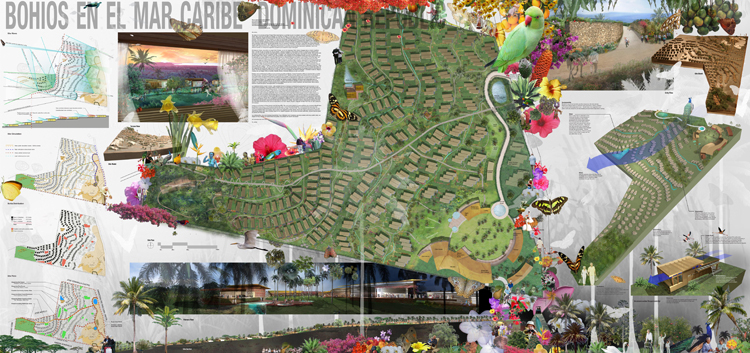
|
|
Bohios en el Mar Caribe Dominican RepublicDominican RepublicWinner of Competition: Hay un pais en el mundo colocado We arrived in Puerto Plata last Tuesday. The skies were filled with the threat of rains, yet it was still very warm. Esteban, a driver from the village, greeted us. We drove through the towns of Sosua and Rio San Juan on our way to our new home in Beruco Alambre. The further away one gets from the airport in Puerto Plata, the greener it becomes. Carretera5 is lined with vendors selling oranges, mangos, guavas, bananas, and papaya. The trees from which the fruit is harvested are just beyond the road. Esteban pulled alongside the roadway and bought some almonds from one of the vendors. As my Spanish needs much honing, he pointed to the broad leaf tree beside us and said “almendra.” The local people live in simple houses called bohios that hug the roadway. The bohios are so colorful and the materials to build them are extracted from the surrounding nature. Dominican Republic lacks the material wealth of other countries, but somehow that is softened by the beauty of the land and the people. Occasionally we catch a glimpse of the ocean, but just enough to keep us wanting more. Esteban drives up a white rocky road. Your dad says it is white because of the limestone – in Spanish it is called caliche. We pass a stream that disappears below the earth and a quarry that has long been mined. Esteban signals that we have arrived. Like this island rising out from the sea, the entry threshold – el zaguan – is a pair of ancient limestone walls surrounded by a variety of native plants: anon, mamon, caimito, jagua, jobo, and mamey. We drive between the walls; Esteban slows as the captivating view to el mar caribe completely opens up. Esteban directs our view to Loma La Cantera, Loma El Morro, and Rio San Juan. The walls transition to a labyrinth of caña – azucar y ron del caribe - and all we see is sky. Like the clouds that veil the beauty of the rugged heartland from the air, we arrive at a mist-filled pool. Beyond the pool, royal palms – the national symbol - soar 25 meters above us. Cotica parrots, palmchats, parakeets, and white crowned pigeons roost. Like an amber necklace mined from the La Cordillera Septentrional, the lobby, restaurant, night bar, clubhouse, gym, buffet, market, shops, dispensary, and school embrace la palmera. This is the village – a terra rosa stage. A lecture on Taino culture is being presented in the clubhouse. People are swimming in the cenote – a freshwater-filled limestone pool. These ancient sinkholes are distinguishing features of a karst – underlain by limestone - landscape. A man practices putting beneath the palmera, while a dance class is being taught to merengue. Sounds of music by Luis Vargas, Fefita La Grande, Rafaelito Roman, Fernando Villanova, and Juan Luis Guerra seep from village. Esteban leads us to the lobby where we are greeted by Marisol. I felt as if I was on vacation in a luxurious resort – but this is our new home. Marisol guides us down el camino al rio to our bohio – the locals traditionally used this roadway to access arroyo grande when they did not have running water. Along the way, there are craft kiosks where small groups were learning to make ceramic tinajas, canastas made of bejuco, and carving bateas from mahogony. A couple of men were huddled below an avocado tree entranced in a game of domino. The skies finally gave way to the rains and, as quickly as they came they stop, gracing us with a beautiful rainbow. I felt like I was walking through a jardin botanico, colorful with cayena, bougainvillea, and orchids everywhere. The bohios follow the land – they dance merengue -- gradually stepping down, always revealing views to the ocean and mountains. We have a private garden – I will spend many hours here. Dad fell asleep on the hammock on the terrace yesterday while reading his paper. He walks around with his camera as we are discovering fauna and flora that we have never seen. It is like living in our own private nature preserve. We wake up every morning to a wonderful view out to the bahia, the aromatic scent of the gardens, have breakfast on the terrace. It will not be a difficult transition to learn to live on the terraces where you can feel la brisa and smell the rains. The arrangement of the bohios – following the landscape so closely – gives us a sense of privacy, but we also feel connected to the larger community. We have started to meet our neighbors – we are looking forward to making new friends. We also have cleaning and laundry service! The village has a great beauty and water therapy center that is hidden in a dense forest – la selva. We access the center on an elevated wood platform, moving up through the canopy of trees. Dad can relax in the bar while I get a manicure. In the evening, we walk to Restaurante Quisqueya that specializes in traditional Dominican dishes overlooking a natural ravine where we have fresh mahi mahi, casabe, and papaya. Nightfall brings a tranquility on the village. Yesterday we joined a couple from the States for a night cap in the palmera and a film in the clubhouse ‘In the Time of the Butterflies’ based on a novel by Julia Alvarez set in Dominican Republic during the era of Trujillo. There is no shortage of activities. Tonight we chose to sit in the garden and watch the stars dance across the sky. Dad has started reading a novel Una vez un hombre by José Enrique Garcia. Me, I love my poetry, I have enclosed one from a book of poems by Pedro Mir.
In association with ITECDESIGN. |
|
||||||||||||||||
|
|